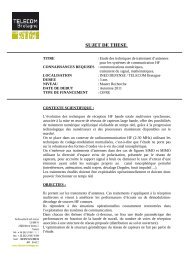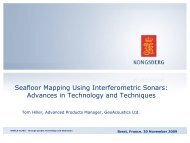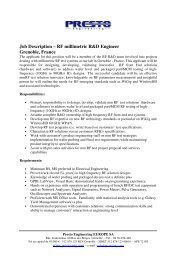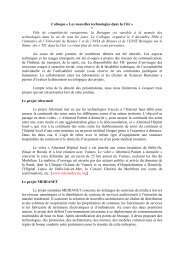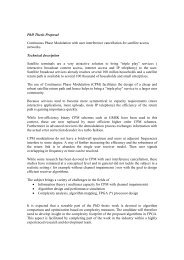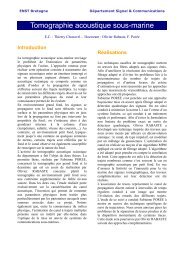Département Réseau, Sécurité et Multimédia Rapport d'Activités 2008
Département Réseau, Sécurité et Multimédia Rapport d'Activités 2008
Département Réseau, Sécurité et Multimédia Rapport d'Activités 2008
You also want an ePaper? Increase the reach of your titles
YUMPU automatically turns print PDFs into web optimized ePapers that Google loves.
Pack<strong>et</strong> scheduling and resource sharing in HSDPAResearch Staff : David Ros, Laurent Toutain – Ph.D. Student : Kamal Deep Singh (IRISA)Keywords : HSDPA, scheduling, video streaming, subjective video qualityApplications : UMTS n<strong>et</strong>work, mobile multimediaPartners & Funding : in collaboration with IRISAIntroductionHigh Speed Downlink Pack<strong>et</strong> Access (HSDPA)is a pack<strong>et</strong>-based data service in UMTSn<strong>et</strong>works that supports data rates of severalMbit/s, making it suitable for data applicationsranging from file transfer to multimediastreaming. In spite of the fairly high data ratesthat HSDPA offers, the shared downlink radiochannel used in HSDPA is still a challengingenvironment for delay- and loss-sensitiveapplications like video streaming.The first issue we have dealt with is thegeneral problem of resource partitioning forshared wireless links like HSDPA. Weconsidered different QoS classes or usergroups, as shown in the figure below. We havestudied how resource allocation among thosegroups, as well as b<strong>et</strong>ween individual users,may be done using HSDPA MAC-layerscheduling.In the past, we have looked at several issuesrelated to the streaming of video over wirelesslinks in general, and HSDPA in particular. Themore recent work reported here concerns thecomplementary issues of pack<strong>et</strong> schedulingand resource sharing in HSDPA.This work was performed in the framework ofa Ph.D. thesis funded by the Conseil Régionalde Br<strong>et</strong>agne, co-advised by two staff membersof the RSM department. The thesis has beenfinished on December 2007 [1].RealizationIn wired links, the task of partitioningresources (e.g., bandwidth) among flows, flowaggregates, users, <strong>et</strong>c. is relatively easy sinc<strong>et</strong>he link capacity is known and fixed.Nevertheless, such partitioning is complex forwireless links with variable capacity; due to thedynamic nature of the link, it is difficult toeffectively allocate the resources (i.e., timeslots) b<strong>et</strong>ween users who may be payingdifferent prices for different services.One of the salient points of HSDPA is the useof MAC-layer scheduling to perform resourcemanagement (i.e., bandwidth allocationb<strong>et</strong>ween terminals), taking into account theradio channel conditions of all users. In someproposals, additional factors like fairnessb<strong>et</strong>ween users, cell throughput or quality-ofservice(QoS) param<strong>et</strong>ers are also consideredin the scheduling mechanism.Without loss of generality, we have focused onthe case in which there are two classes: oneconsists in best-effort (BE) users, and theother class in video streaming users. Existingscheduling schemes often allocate resources insuch a way that the BE users are notguaranteed any time slots; they only g<strong>et</strong> theresidual time slots after the QoS requirementsof the other users are satisfied. This type ofresource allocation can cause instability, in thesense that during congestion periods the BEusers will be starved. Note that even a singleuser in a higher-QoS class, suffering with badchannel quality (even if temporarily), cancause starvation to the BE users. Starvationwill last at least for the time needed by theRNC to step in and take appropriatecongestion control measuresIn order to perform hierarchical link sharing(i.e., b<strong>et</strong>ween QoS classes and then b<strong>et</strong>weenusers in each class), a variant of an existingscheduler, the so-called Required ActivityD<strong>et</strong>ection scheduler [2], was introduced in [3].Also, in order to avoid the starvation problemdescribed above, we proposed that a lowerclass be considered a single virtual user of thenext higher-QoS class. This type of allocation isthen applied iteratively for all the otherPracom’s Annual Report <strong>2008</strong> 19




